Physical Address
304 North Cardinal St.
Dorchester Center, MA 02124
The craniofacial skeleton can be reconstructed with both autogenous bone and alloplastic implants. Alloplastic implants are used only as onlay grafts to the native skeleton to improve facial contour and to replace missing portions of the non-load-bearing cranial vault and internal orbit. Autogenous bone may be used for these purposes, but is more suited to replace segmental, load-bearing defects of the facial skeleton. Virtually all aesthetic facial skeletal augmentation, as well as cranial vault replacement, is done with alloplastic materials. Three basic categories of alloplastic materials are used in facial reconstruction. Polymers and ceramics are used to replace or augment bone. Metals are used as fixation or support devices.
Autogenous bone has long been considered the standard material to restore or improve the craniofacial skeleton because it has the potential to become revascularized and then assimilated into the facial skeleton. In time, it could be biologically indistinguishable from the adjacent native skeleton. These attributes make it ideal and the only material available to reliably reconstruct segmental load-bearing defects of the facial skeleton. When used as an onlay graft, these attributes lead to graft resorption and unreliable augmentation of the facial skeleton.
Clinical experience and laboratory investigation have revealed that the fate of non-vascularized onlay bone grafts placed in the craniofacial skeleton depends on three interrelated factors: the architecture of the graft, its revascularization, and the recipient site.
Onlay grafts harvested from the calvarium are superior to grafts harvested from the iliac crest in volume maintenance. This difference was initially attributed to the embryonic origin of the graft, prompting use of the terms membranous and endochondral grafts as opposed to the anatomic terms calvarial and iliac crest grafts. Kusiak et al. reported that calvarial bone grafts become revascularized earlier than iliac grafts, and attributed this volume maintenance to their early revascularization. However, this explanation was questioned when Lin et al. and Sullivan et al. reported more extensive revascularization in iliac crest grafts.
Lin evaluated the volume persistence of calvarial and iliac crest grafts fixed to the rabbit snout with lag screws ( Fig. 3.1 ). Early revascularization of the grafts occurred only in the cancellous portion of both grafts suggesting that the cortical portion of the grafts acted as a mechanical barrier to ingrowing blood vessels ( Fig. 3.2 ). This observation prompted Chen’s study.
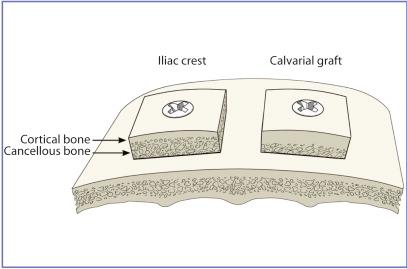
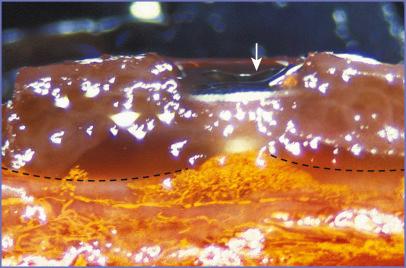
Using a model similar to Lin’s, Chen et al. also evaluated the volume persistence of calvarial and iliac crest grafts fixed to the rabbit snout with lag screws. In addition, Chen correlated graft revascularization and graft resorption with graft architecture in the cortical and cancellous regions of both calvarial and iliac grafts. Revascularization was evaluated using latex vascular cast injection, while osteoclastic activity was evaluated using a tartrate-resistant acid phosphatase stain. As expected, he found that at 70 days the calvarial grafts demonstrated greater volume maintenance than the iliac bone (72% vs. 32%, P < .025). He found significantly greater revascularization and osteoclastic activity in the cancellous portion of both the calvarial and iliac crest bone grafts by the 10th day after onlay grafting. Minimal activities were present in the cortical bone ( Figs. 3.3 and 3.4 ). Because calvarial grafts contain more cortical bone, the superior volume maintenance can be understood by the influence of bone architecture on revascularization and resorption. Cortical bone is more slowly revascularized, and therefore less available to osteoclastic activity. The amount of cortical bone in an onlay graft determines its volume maintenance. The importance of graft architecture, as opposed to its embryologic origin, to the volume persistence of onlay bone grafts has been supported in later studies by Gosain.
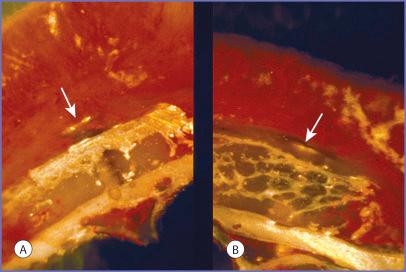
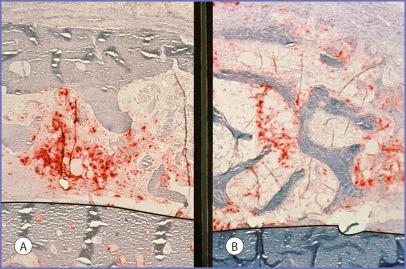
Chen’s study also explained the observation of others that rigid fixation improves graft volume maintenance. Lag screw fixation obliterates the gap between the graft and the recipient bed and therefore may reduce neovascularization of the graft at this interface. Rigid fixation may therefore improve the volume maintenance of onlay bone grafts by limiting, rather than facilitating, revascularization of the graft.
The volume maintenance of a bone graft depends on where it is placed. Zins et al. originally proposed that bone grafts placed in depository fields on the growing facial skeleton would have improved volume maintenance. Gosain et al., using an adult animal model, found complete or near-complete resorption of onlay bone grafts over 1 year (despite the use of rigid fixation and irrespective of their depository or resorptive recipient beds). Rather than its embryologic role in facial growth, the recipient site impacts the fate of a bone graft by the functional stresses it places on the graft. These stresses are determined by regional musculoskeletal forces and by deforming forces of the overlying soft tissue envelope.
The description of this phenomenon is attributed to the German anatomist Julius Wolff, and has long been referred to as Wolff’s Law. It was described for the axial skeleton but is equally applicable to the craniofacial skeleton. When used as an interposition or inlay graft to fill a defect in a location with significant musculoskeletal forces acting on it, for example the mandible, functional stresses will result in the graft’s eventual remodeling into a size and shape similar to the segment it is replacing. When the bone replaced provides a more protective function with little stress on it, for example the cranial vault, the graft loses volume due to osteolysis, as well as revascularization and osteoclastic resorption. Similarly, the volume persistence of an onlay bone graft will be determined by the musculoskeletal forces working on them and the deforming forces of the overlying soft tissue envelope. This translation of mechanical forces into chemical or electrical signals to elicit cell activity is termed “mechanotransduction,” where osteocytes are believed to be the primary mediators. When stressed, osteocytes convert the mechanical forces into molecular signals, which result in bone remodeling.
In summary, the fate of an onlay bone graft is unpredictable but depends on its revascularization and factors that impact its subsequent remodeling. If a bone graft does not become revascularized, it acts like a sequestrum, which remains inert and can maintain its volume indefinitely. This realization prompted the senior author’s use of certain alloplastic materials to replace or augment the facial skeleton. The use of alloplastic materials also has the advantage of avoiding the morbidity, time, and cost associated with autogenous graft harvest.
Autogenous bone graft has long been considered the gold standard material for facial skeleton reconstruction. The term “gold standard” is derived from economics, where the standard economic unit of account is based on a fixed quantity of gold. Gold was chosen because, of all major metals, it is the most resistant to corrosion, and therefore maintains its volume and value over time. Ironically, as noted above, volume retention is not an attribute of autogenous bone when used as an onlay graft.
After a bone graft is revascularized, its volume will be determined by functional stresses.
In the realm of facial skeletal augmentation, cartilage has a limited role except for nasal onlay grafts. Advantages for using cartilage include lowest rate of resorption (since it is not vascularized) and extrusion. Potential donor sites include auricular, nasal septal, and costal grafts. Costal cartilage grafts provide an ample source of cartilage for nasal dorsal augmentation. However, cartilage grafts have a tendency to warp and their donor site is not free of morbidity. Cadaveric cartilage presents an alternative source of cartilage, free of donor site morbidity, with reports of good tissue compatibility and low rate of infection. However, the problem of warping remains, regardless of whether the cartilage was irradiated or not. Graft resorption has been reported as well.
Autogenous fat grafting has become a valuable addition to both the reconstructive and aesthetic procedural armamentarium. However, it is important to emphasize that there is a difference in the resultant facial contour when it is altered by expanding the soft tissue envelope as opposed to increasing the projection of the underlying skeleton. Small augmentation of either the underlying skeleton or the overlying soft tissue envelope may result in changes to the facial contour that are almost clinically imperceptible. However, when skeletal or soft tissue deficits become more severe, their correction requires use of the appropriate tissue or tissue substitute. Although both modalities result in an augmentation of facial contour, the aesthetic result obtained with fat grafting is different from that of skeletal advancement. A progressive increase in the projection of the facial skeleton by osteotomy and advancement or alloplastic augmentation results in a facial contour that is increasingly skeletal and defined. On the other hand, a progressive increase in the volume of the overlying soft tissue envelope results in a facial contour that is increasingly less defined. An example is shown in Fig. 3.5 .

Virtually all aesthetic facial skeletal augmentation is done with alloplastic materials. The use of synthetic material avoids donor-area morbidity while vastly simplifying the procedure in terms of time and complexity. Implant materials used for facial skeletal augmentation are biocompatible; that is, they have an acceptable reaction between the material and the host. In general, the host has little or no enzymatic ability to degrade the implant, with the result that the implant tends to maintain its volume and shape. Likewise, the implant has a minimal and predictable effect on the host tissue that surrounds it. This type of relationship is an advantage over the use of autogenous bone or cartilage which, when vascularized, will be remodeled to varying degrees, thereby changing volume and shape.
The alloplastic implants currently used for facial reconstruction have not shown to have any toxic effects on the host. The host responds to these materials by forming a fibrous capsule around the implant, which is the body’s way of isolating the implant from the host. The most important implant characteristic that determines the nature of the encapsulation is the implant’s surface. Smooth implants result in the formation of smooth-walled capsules ( Fig. 3.6 ). Porous implants allow varying degrees of soft tissue ingrowth, which results in a less dense capsule ( Fig. 3.7 ).
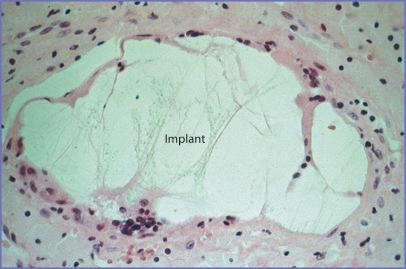
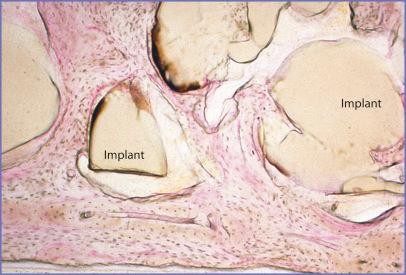
Animal studies have demonstrated that implant pore sizes of more than 100 μm encourage tissue ingrowth. Pore sizes of less than 100 μm limit tissue ingrowth. Materials with large pore sizes (>300 μm) have drawbacks associated with material breakdown. As a result of fibrous tissue ingrowth, it is a clinical observation that porous implants have a lesser tendency to erode underlying bone and to migrate due to soft tissue mechanical forces.
The surface characteristic of an implant influences the surrounding soft tissue response to the implant. Smooth-surfaced implants induce denser capsule formation than porous implants.
Three basic categories of alloplastic materials are used in facial reconstruction. Polymers and ceramics are used to replace or augment bone. Metals are used as fixation or support devices.
Become a Clinical Tree membership for Full access and enjoy Unlimited articles
If you are a member. Log in here